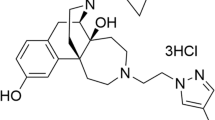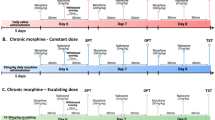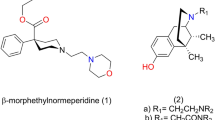Abstract
Studies in experimental animals have shown that individuals exhibiting enhanced sensitivity to the locomotor-activating and rewarding properties of drugs of abuse are at increased risk for the development of compulsive drug-seeking behavior. The purpose of the present study was to assess the effect of constitutive deletion of delta-opioid receptors (DOPr) on the rewarding properties of morphine as well as on the development of sensitization and tolerance to the locomotor-activating effects of morphine. Locomotor activity testing revealed that mice lacking DOPr exhibit an augmentation of context-dependent sensitization following repeated, alternate injections of morphine (20 mg/kg; s.c.; 5 days). In contrast, the development of tolerance to the locomotor-activating effects of morphine following chronic morphine administration (morphine pellet: 25 mg: 3 days) is reduced relative to WT mice. The conditioned rewarding effects of morphine were reduced significantly in DOPrKO mice as compared to WT controls. Similar findings were obtained in response to pharmacological inactivation of DOPr in WT mice, indicating that observed effects are not due to developmental adaptations that occur as a consequence of constitutive deletion of DOPr. Together, these findings indicate that the endogenous DOPr system is recruited in response to both repeated and chronic morphine administration and that this recruitment serves an essential function in the development of tolerance, behavioral sensitization, and the conditioning of opiate reward. Importantly, they demonstrate that DOPr has a distinct role in the development of each of these drug-induced adaptations. The anti-rewarding and tolerance-reducing properties of DOPr antagonists may offer new opportunities for the treatment and prevention of opioid dependence as well as for the development of effective analgesics with reduced abuse liability.
Similar content being viewed by others
Log in or create a free account to read this content
Gain free access to this article, as well as selected content from this journal and more on nature.com
or
References
Abdelhamid EE, Sultana M, Portoghese PS, Takemori AE (1991). Selective blockage of delta opioid receptors prevents the development of morphine tolerance and dependence in mice. J Pharmacol Exp Ther 258: 299–303.
Bailey CP, Connor M (2005). Opioids: cellular mechanisms of tolerance and physical dependence. Curr Opin Pharmacol 5: 60–68.
Cahill C M, Morinville A, Lee M C, Vincent J P, Collier B, Beaudet A (2001). Prolonged morphine treatment targets delta opioid receptors to neuronal plasma membranes and enhances delta-mediated antinociception. J Neurosci 21: 7598–7607.
Carr GD, Fibiger HC, Phillips AG (1989). Conditioned place preference as a measure of drug reward. In: Liebman JM, Cooper SJ (eds). Neuropharmacological Basis of Reward. Oxford Science Publications, Oxford, New York. pp 264–319.
Clarke S, Czyzyk T, Ansonoff M, Nitsche JF, Hsu MS, Nilsson L et al (2002). Autoradiography of opioid and ORL1 ligands in opioid receptor triple knockout mice. Eur J Neurosci 16: 1705–1712.
Cohen ML, Shuman RT, Osborne JJ, Gesellchen PD (1986). Opioid agonist activity of ICI 174864 and its carboxypeptidase degradation product, LY281217. J Pharmacol Exp Ther 238: 769–772.
Contet C, Filliol D, Matifas A, Kieffer BL (2007). Morphine-induced analgesic tolerance, locomotor sensitization and physical dependence do not require modification of mu opioid receptor, cdk5 and adenylate cyclase activity. Neuropharmacology 54: 475–486.
Corbett AD, Henderson G, McKnight AT, Paterson SJ (2006). 75 years of opioid research: the exciting but vain quest for the Holy Grail. Br J Pharmacol 147 (Suppl 1): S153–S162.
Cunningham CL, Niehus DR, Malott DH, Prather LK (1992). Genetic differences in the rewarding and activating effects of morphine and ethanol. Psychopharmacology (Berl) 107: 385–393.
Cunningham CL, Henderson CM, Bormann NM (1998). Extinction of ethanol-induced conditioned place preference and conditioned place aversion: effects of naloxone. Psychopharmacology (Berl) 139: 32–70.
Cunningham CL, Ferree NK, Howard MA (2003). Apparatus bias and place conditioning with ethanol in mice. Psychopharmacology (Berl) 170: 409–422.
Cunningham CL, Gremel CM, Groblewski PA (2006). Drug-induced conditioned place preference and aversion in mice. Nat Protoc 1: 1662–1670.
Daniels DJ, Lenard NR, Etienne CL, Law PY, Roerig SC, Portoghese PS (2005). Opioid-induced tolerance and dependence in mice is modulated by the distance between pharmacophores in a bivalent ligand series. Proc Natl Acad Sci USA 102: 19208–19213.
Di Chiara G, Bassareo V (2007). Reward system and addiction: what dopamine does and doesn't do. Curr Opin Pharmacol 7: 69–76.
Eitan S, Bryant CD, Saliminejad N, Yang YC, Vojdani E, Keith Jr D et al (2003). Brain region-specific mechanisms for acute morphine-induced mitogen-activated protein kinase modulation and distinct patterns of activation during analgesic tolerance and locomotor sensitization. J Neurosci 23: 8360–8369.
Filliol D, Ghozland S, Chluba J, Martin M, Matthes HW, Simonin F et al (2000). Mice deficient for delta- and mu-opioid receptors exhibit opposing alterations of emotional responses. Nat Genet 25: 195–200.
Fundytus ME, Schiller PW, Shapiro M, Weltrowska G, Coderre TJ (1995). Attenuation of morphine tolerance and dependence with the highly selective delta-opioid receptor antagonist TIPP[psi]. Eur J Pharmacol 286: 105–108.
Gibaldi M, Perier D (1975). The trapezoid rule. In: Gibaldi M, Perier D (eds). Pharmacokinetics. Marcel Dekker: New York. pp 293–296.
Goody RJ, Oakley SM, Filliol D, Kieffer BL, Kitchen I (2002). Quantitative autoradiographic mapping of opioid receptors in the brain of delta-opioid receptor gene knockout mice. Brain Res 945: 9–19.
Gupta A, Decaillot FM, Devi LA (2006). Targeting opioid receptor heterodimers: strategies for screening and drug development. AAPS J 8: E153–E159.
Heidbreder CA, Goldberg SR, Shippenberg TS (1993). The kappa-opioid receptor agonist U-69593 attenuates cocaine-induced behavioral sensitization in the rat. Brain Res 616: 335–338.
Heidbreder CA, Shippenberg TS (1994). U-69593 prevents cocaine sensitization by normalizing basal accumbens dopamine. Neuroreport 5: 1797–1800.
Heidbreder C, Shoaib M, Shippenberg TS (1996). Differential role of delta-opioid receptors in the development and expression of behavioral sensitization to cocaine. Eur J Pharmacol 298: 207–216.
Hyman SE (2005). Addiction: a disease of learning and memory. Am J Psychiatry 162: 1414–1422.
Jordan BA, Devi LA (1999). G-protein-coupled receptor heterodimerization modulates receptor function. Nature 399: 697–700.
Kalivas PW (1992). Neural substrate of sensitization to psychostimulants. Clin Neuropharmacol 15 (Suppl 1 Part A): 648–649A.
Kornetsky C (2004). Brain-stimulation reward, morphine-induced oral stereotypy, and sensitization: implications for abuse. Neurosci Biobehav Rev 27: 777–786.
Law PY, Erickson-Herbrandson LJ, Zha QQ, Solberg J, Chu J, Sarre A et al (2005). Heterodimerization of mu- and delta-opioid receptors occurs at the cell surface only and requires receptor-G protein interactions. J Biol Chem 280: 11152–11164.
Lenard NR, Daniels DJ, Portoghese PS, Roerig SC (2007). Absence of conditioned place preference or reinstatement with bivalent ligands containing mu-opioid receptor agonist and delta-opioid receptor antagonist pharmacophores. Eur J Pharmacol 566: 75–82.
Matthes HW, Maldonado R, Simonin F, Valverde O, Slowe S, Kitchen I et al (1996). Loss of morphine-induced analgesia, reward effect and withdrawal symptoms in mice lacking the mu-opioid-receptor gene. Nature 383: 819–823.
Miyamoto Y, Portoghese PS, Takemori AE (1993). Involvement of delta 2 opioid receptors in acute dependence on morphine in mice. J Pharmacol Exp Ther 265: 1325–1327.
Morinville A, Cahill CM, Esdaile MJ, Aibak H, Collier B, Kieffer BL et al (2003). Regulation of delta-opioid receptor trafficking via mu-opioid receptor stimulation: evidence from mu-opioid receptor knock-out mice. J Neurosci 23: 4888–4898.
Morinville A, Cahill CM, Kieffer B, Collier B, Beaudet A (2004). Mu-opioid receptor knockout prevents changes in delta-opioid receptor trafficking induced by chronic inflammatory pain. Pain 109: 266–273.
Narita M, Suzuki T, Funada M, Misawa M, Nagase H (1993). Involvement of delta-opioid receptors in the effects of morphine on locomotor activity and the mesolimbic dopaminergic system in mice. Psychopharmacology (Berl) 111: 423–426.
Nieto MM, Guen SL, Kieffer BL, Roques BP, Noble F (2005). Physiological control of emotion-related behaviors by endogenous enkephalins involves essentially the delta opioid receptors. Neuroscience 135: 305–313.
Nitsche JF, Schuller AG, King MA, Zengh M, Pasternak GW, Pintar JE (2002). Genetic dissociation of opiate tolerance and physical dependence in delta-opioid receptor-1 and preproenkephalin knock-out mice. J Neurosci 22: 10906–10913.
Portoghese PS, Sultana M, Takemori AE (1988). Naltrindole, a highly selective and potent non-peptide delta opioid receptor antagonist. Eur J Pharmacol 146: 185–186.
Portoghese PS, Sultana M, Nelson WL, Klein P, Takemori AE (1992). Delta opioid antagonist activity and binding studies of regioisomeric isothiocyanate derivatives of naltrindole: evidence for delta receptor subtypes. J Med Chem 35: 4086–4091.
Roberts AJ, Gold LH, Polis I, McDonald JS, Filliol D, Kieffer BL et al (2001). Increased ethanol self-administration in delta-opioid receptor knockout mice. Alcohol Clin Exp Res 25: 1249–1256.
Robinson TE, Berridge KC (1993). The neural basis of drug craving: an incentive-sensitization theory of addiction. Brain Res Brain Res Rev 18: 247–291.
Robinson TE, Berridge KC (2000). The psychology and neurobiology of addiction: an incentive-sensitization view. Addiction 95 (Suppl 2): S91–S117.
Rozenfeld R, Abul-Husn NS, Gomez I, Devi LA (2007). An emerging role for the delta opioid receptor in the regulation of mu opioid receptor function. ScientificWorldJournal 7: 64–73.
Schenk S, Ellison F, Hunt T, Amit Z (1985). An examination of heroin conditioning in preferred and nonpreferred environments and in differentially housed mature and immature rats. Pharmacol Biochem Behav 22: 215–220.
Schenk S, Partridge B, Shippenberg TS (2001). Effects of the kappa-opioid receptor agonist, U69593, on the development of sensitization and on the maintenance of cocaine self-administration. Neuropsychopharmacology 24: 441–450.
Schiller PW, Fundytus ME, Merovitz L, Weltrowska G, Nguyen TM, Lemieux C et al (1999). The opioid mu agonist/delta antagonist DIPP-NH(2)[Psi] produces a potent analgesic effect, no physical dependence, and less tolerance than morphine in rats. J Med Chem 42: 3520–3526.
Shippenberg TS, Bals-Kubik R, Herz A (1987). Motivational properties of opioids: evidence that an activation of delta-receptors mediates reinforcement processes. Brain Res 436: 234–239.
Simonin F, Slowe S, Becker JA, Matthes HW, Filliol D, Chluba J et al (2001). Analysis of [3H]bremazocine binding in single and combinatorial opioid receptor knockout mice. Eur J Pharmacol 414: 189–195.
Sora I, Takahashi N, Funada M, Ujike H, Revay RS, Donovan DM et al (1997). Opiate receptor knockout mice define mu receptor roles in endogenous nociceptive responses and morphine-induced analgesia. Proc Natl Acad Sci USA 94: 1544–1549.
Spanagel R, Shippenberg TS (1993). Modulation of morphine-induced sensitization by endogenous kappa opioid systems in the rat. Neurosci Lett 153: 232–236.
Stewart PE, Hammond DL (1993). Evidence for delta opioid receptor subtypes in rat spinal cord: studies with intrathecal naltriben, cyclic[D-Pen2, D-Pen5] enkephalin and [D-Ala2, Glu4]Deltorphin. J Pharmacol Exp Ther 266: 820–828.
Suzuki T, Yoshiike M, Mizoguchi H, Kamei J, Misawa M, Nagase H (1994). Blockade of delta-opioid receptors prevents morphine-induced place preference in mice. Jpn J Pharmacol 66: 131–137.
Swerdlow NR, Gilbert D, Koob GF (1989). Conditioned drug effects on spatial preference: critical evaluation. In: Boulton AA, Baker GB, Greenshaw AJ (eds). Psychopharmacology (Neuromethods Vol 13). Humana Press: Clifton. pp 399–446.
Timar J, Gyarmati Z, Furst Z (2005). The development of tolerance to locomotor effects of morphine and the effect of various opioid receptor antagonists in rats chronically treated with morphine. Brain Res Bull 64: 417–424.
Vanderschuren LJ, Everitt BJ (2005). Behavioral and neural mechanisms of compulsive drug seeking. Eur J Pharmacol 526: 77–88.
Wells JL, Bartlett JL, Ananthan S, Bilsky EJ (2001). In vivo pharmacological characterization of SoRI 9409, a nonpeptidic opioid mu-agonist/delta-antagonist that produces limited antinociceptive tolerance and attenuates morphine physical dependence. J Pharmacol Exp Ther 297: 597–605.
Zernig G, Ahmed SH, Cardinal RN, Morgan D, Acquas E, Foltin RW et al (2007). Explaining the escalation of drug use in substance dependence: models and appropriate animal laboratory tests. Pharmacology 80: 65–119.
Zhu Y, King MA, Schuller AG, Nitsche JF, Reidl M, Elde RP et al (1999). Retention of supraspinal delta-like analgesia and loss of morphine tolerance in delta opioid receptor knockout mice. Neuron 24: 243–252.
Acknowledgements
We thank Vicki Minney and Eric Oh for their excellent technical assistance.
Author information
Authors and Affiliations
Corresponding author
Additional information
DISCLOSURE/CONFLICT OF INTEREST
The authors declare that, except for income received from their primary employer, no financial support or compensation has been received from any individual or corporate entity over the past 3 years for research or professional service and there are no personal financial holdings that could be perceived as constituting a potential conflict of interest.
Rights and permissions
About this article
Cite this article
Chefer, V., Shippenberg, T. Augmentation of Morphine-Induced Sensitization but Reduction in Morphine Tolerance and Reward in Delta-Opioid Receptor Knockout Mice. Neuropsychopharmacol 34, 887–898 (2009). https://doi.org/10.1038/npp.2008.128
Received:
Revised:
Accepted:
Published:
Issue date:
DOI: https://doi.org/10.1038/npp.2008.128
Keywords
This article is cited by
-
Different Roles of Beclin1 in the Interaction Between Glia and Neurons after Exposure to Morphine and the HIV- Trans-Activator of Transcription (Tat) Protein
Journal of Neuroimmune Pharmacology (2022)
-
Morphine coordinates SST and PV interneurons in the prelimbic cortex to disinhibit pyramidal neurons and enhance reward
Molecular Psychiatry (2021)
-
Astrocytes determine conditioned response to morphine via glucocorticoid receptor-dependent regulation of lactate release
Neuropsychopharmacology (2020)
-
Agonist-induced phosphorylation bar code and differential post-activation signaling of the delta opioid receptor revealed by phosphosite-specific antibodies
Scientific Reports (2020)
-
HIV-1 Tat and opioids act independently to limit antiretroviral brain concentrations and reduce blood–brain barrier integrity
Journal of NeuroVirology (2019)



